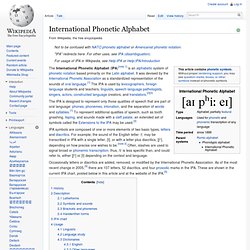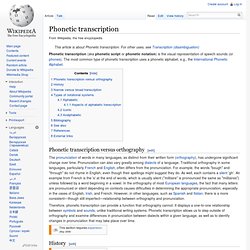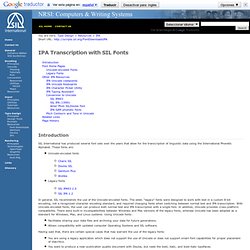

Sound/IPA symbols. International Phonetic Alphabet. The International Phonetic Alphabet (IPA)[note 1] is an alphabetic system of phonetic notation based primarily on the Latin alphabet.

It was devised by the International Phonetic Association as a standardized representation of the sounds of oral language.[1] The IPA is used by lexicographers, foreign language students and teachers, linguists, speech-language pathologists, singers, actors, constructed language creators, and translators.[2][3] History[edit] The International Phonetic Alphabet - Audio Illustrations. IPA character picker 11. Ishida >> apps Character pickers are especially useful for people who don't know a script well, as characters are displayed in ways that aid identification.

See the notes for details. Click on characters to create text in the box, then copy & paste to your content. International Phonetic Alphabet chart for English dialects. International Phonetic Alphabet (IPA) Origin The IPA was first published in 1888 by the Association Phonétique Internationale (International Phonetic Association), a group of French language teachers founded by Paul Passy.

The aim of the organisation was to devise a system for transcribing the sounds of speech which was independent of any particular language and applicable to all languages. A phonetic script for English created in 1847 by Isaac Pitman and Henry Ellis was used as a model for the IPA. Uses. Phonetic transcription. Phonetic transcription versus orthography[edit] The pronunciation of words in many languages, as distinct from their written form (orthography), has undergone significant change over time.

Pronunciation can also vary greatly among dialects of a language. Traditional orthography in some languages, particularly French and English, often differs from the pronunciation. For example, the words "bough" and "through" do not rhyme in English, even though their spellings might suggest they do. As well, each contains a silent 'gh'. Therefore, phonetic transcription can provide a function that orthography cannot. History[edit] Narrow versus broad transcription[edit] Ipachart. IPA character picker 11. Click on characters to create text in the box below, then copy & paste to your content. p b t d ʈ ɖ c ɟ k ɡ q ɢ ʔ ʰ m ɱ n ɳ ɲ ŋ ɴ ʙ ⱱ r ɾ ɽ ʀ ɸ β f v θ ð s z ʃ ʒ ʂ ʐ ç ʝ x ɣ χ ʁ ħ ʕ h ɦ ʋ ɹ ɻ j ɰ ɬ ɮ l ɭ ʎ ʟ ɫ ƥ ɓ ƭ ɗ ƈ ʄ ƙ ɠ ʠ ʛ ǁ ʘ ǀ ǃ ǂ i y ɨ ʉ ɯ u ɪ ʏ ʊ e ø ɘ ɵ ɤ o ə ɛ œ ɜ ɞ ʌ ɔ æ ɐ a ɶ ɑ ɒ ̋ ˥ ̌ ˩˥ ́ ˦ ̂ ˥˩ ̄ ˧ ᷄ ˦˥ ̀ ˨ ᷅ ˩˨ ̏ ˩ ᷈ ˧˦˧ ↓ ↗ ↑ ↘ ʍ w ɥ ʜ ʢ ʡ ɕ ʑ ɧ ɺ ʦ ʣ ʧ ʤ ʨ ʥ ɚ ɝ / [ ] ː ˑ ̆ ˈ ˌ | ‖ . ‿ φ ω σ μ ̥ ̊ ̬ ̤ ̰ ͓ ̼ ̺ ̪ ̻ ̹ ̜ ̟ ̠ ̈ ̽ ̩ ̯ ˞ ̮ ̙ ̘ ̞ ̝ ̴ ̃ ̨ ͊ ͋ ̚ ʼ ˭ ⁿ ˡ ˤ ˠ ʲ ʷ ͡ ͜ Font list: Custom font: Size: Rows: Add codepoint:

IPA Berg. Interactive Sagittal Section. IPA. You are here: Type Design > Resources > IPA Short URL: Introduction Font Home Pages Unicode-encoded Fonts Legacy Fonts Other IPA Resources IPA Unicode codepoints IPA Unicode Keyboards IPA Character Picker Utility IPA Typing Assistant Conversion to Unicode SIL IPA93 SIL IPA (1990) Amer Phon SILDoulos font IPA-SAM phonetic fonts Pitch Contours and Tone in Unicode Related Links Page History Introduction SIL International has produced several font sets over the years that allow for the transcription of linguistic data using the International Phonetic Alphabet.

These fonts are: In general, SIL recommends the use of the Unicode-encoded fonts. Facilitates sharing your data files and archiving your data for future generations. Having said that, there are certain special cases that may warrant the use of the legacy fonts: You are using a legacy application which does not support the use of Unicode or does not support smart-font capabilities for proper placement of diacritics. Font Home Pages. Linguistics Handbook. Cambridge University Press (1999) The Handbook of the International Phonetic Association was published by Cambridge University Press in July of 1999 and is being regularly reprinted in both hardback and paperback. The audio recordings contained here are the words and text that appear in the illustrations contained in Part 2 of the Handbook and which demonstrate the application of the International Phonetic Alphabet to a wide variety of sound systems of languages of the world.
The zipped* folders of audio files (as well as PDF* files containing revisions or other information) are available for downloading individually by language here. IPA. IPA: International Phonetic Association. IPA: Sounds. Handbook of the IPA: Sound Recordings The audio files to accompany the language Illustrations in Part 2 of the Handbook of the IPA may be downloaded from the Editor’s web site at the University of Victoria. Click here.
The sounds of English and the International Phonetic Alphabet. © Tomasz P.

Szynalski, Antimoon.com This chart contains all the sounds (phonemes) used in the English language. For each sound, it gives: The symbol from the International Phonetic Alphabet (IPA), as used in phonetic transcriptions in modern dictionaries for English learners — that is, in A. C. English language, alphabet and pronunciation. English is a West Germanic language related to Scots, Dutch, Frisian and German. with a significant amount of vocabulary from Old Norse, Norman French, Latin and Greek, and loanwords from many other languages.

Approximately 341 million people speak English as a native language and a further 267 million speak it as a second language in over 104 countries including the UK, Ireland, USA, Canada, Australia, New Zealand, South Africa, American Samoa, Anguilla, Antigua and Barbuda, Aruba, Bahamas, Barbados, Belize, Bermuda, Botswana, British Indian Ocean Territory, British Virgin Islands, Brunei, Cameroon, Canada, Cayman Islands, and the Cook Islands.